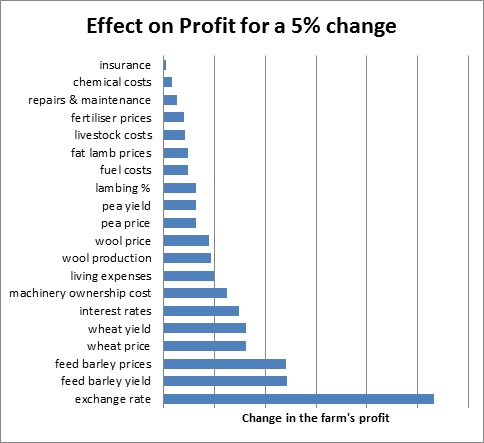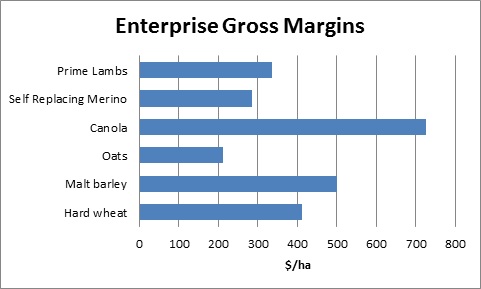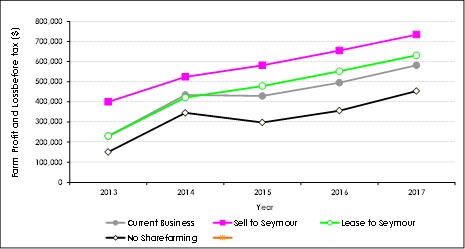Drivers of profitability in farm business
Author: Mike Krause | Date: 13 Aug 2013
Keywords: profitability, business performance
Take home messages:
- Have a written vision and set of goals
- Planning, implement and monitor
- Balance of ‘within season’ and ‘beyond this season’ management
- Clearly understand the strengths and weaknesses in the business, then manage the weaknesses
- Understand the true financial capacity of your business
- Continually strive for improvement and investigate better ways to achieve your business vision
- If you aren’t measuring business performance, how can you manage it!
Introduction
The classic response to the question of ‘What are the profit drivers of a farming business?’ would be to list the greatest impacts as the following:
- The level of commodity prices
- The cropping and livestock yields
- The control of expenses
However, experience with farmers through my consulting and training career has shown the following are also as important to farming profits:
- Having a business road map
- Maintaining communications
- Knowing the business capacity
- Knowing how to use advisers
The classic drivers of profit
Essentially, profit is what is left over after covering the costs of running the farming operation for a year. Simply, the formula for profitability is:
Profit = (Production x commodity price) – annual costs
So those items that have greatest impact on profit are the commodity prices that are achieved, the amount of commodities produced and what it costs to run the business in that year.
One way of assessing the relative impact of these items on profit can be shown by using a mixed farm case study (based on figures typical of many mixed farms). Imagine each production, commodity price and cost item that could affect this farm’s profit were isolated and changed by 5%. The results shown in Figure 1 indicate the relative importance that a 5% shift has on business profits.

Figure 1. The impact on a farm’s profit by shifting these items by 5%.
A few observations from this sensitivity analysis:
- Exchange rates provide the biggest impact because they influence all commodity prices that are dependent on exports, which is 90% of this farm’s production.
- Commodity prices and yield changes have the next biggest impact on profits
- Interestingly, the shift in cost items have a lesser impact on profit
- Also interestingly, interest rates are ranked at No.6 on this list because this farm had equity of 65%. If this farm had the average farm equity of 85%, interest rates would have been ranked at No.12.
So, those items that have the greatest impact on farm profits are exchange rates, commodity prices and enterprise yields. What makes this statement even more important is that the items of commodity prices and yields generally vary significantly; greater than 5% between seasons and costs generally vary by the inflation rate of about 2.5%. So, that means commodity prices and yields are even more important to profits.
One could conclude from this analysis that 80% of management should go into managing prices and yields and only 20% into managing costs. Therefore, we should be concerned with the farm’s yield levels and understanding how commodity prices can be better managed with forward selling choices and storage options.
However, the farming business is complex and this analysis is too simplistic! Greater understanding of essential farm business management is required.
The other equally important drivers of profit
Throughout many years of farm business management consulting and farmer training, experience has shown that profitable farm businesses also address these additional items in their management:
- Having a business road map – Some business reference books break this down as vision, mission and goals. A business needs to have written down, what goals they are planning to achieve and how they are going to achieve them. This gives the business great direction and leadership, and more importantly, a clear aim for the business. It is very powerful when all involved in the business share this same ‘business road map’ as it allows for the power of synergy. There is also a saying that ‘If you don’t have a destination in mind, how do you know when you get there?’
It has been my experience that where a business has no plan, it flounders in many areas. When seasonal and market downturns occur and the pressure builds in the business, there is little leadership, profits suffer significantly and the risk of losing the business is increased.
- Maintaining communications – Once a clear plan is developed, sound communication needs to be maintained with the people involved both in and outside of the business. To get the most out of advisers such as accountants and agronomists, as well as those involved in the farm management, there needs to be a clear understanding of where the business is going. Advice can then be directed to the best way of achieving the plan.
Succession planning is challenging at the best of times and there is strong evidence that this is not being handled well in agriculture. A great approach to developing a succession plan is to have good communication among people in the business. If this is not managed correctly, it can become the ‘elephant in the room’ and can negatively impact on family relationships and business success. This is a major issue in agriculture and a major reason why business profits are significantly affected.
- Understanding business capacity – Knowing the business capacity is more than knowing the business benchmarks and how to read the tax return. Once a manager understands the strengths and weaknesses of their business, they can better manage for improvement in profitability. Understanding the business capacity entails:
- Knowing what the range of possible annual profits can be, so there is an understanding of the risk profile.
- Knowing what enterprises are making the profits in the business.
- Having a good understanding of the cost of production and that marketing plans are delivering commodity prices above the cost of production.
- Knowing what the major bank ratios are, so that good business relationships are being maintained with the bank.
- Knowing how efficient your business is and knowing the wealth generation potential.
It takes discipline to put this information together for a farming business, and from my experience, most farming businesses don’t know the answers to these fundamental questions. They risk now knowing how to manage for improved profit.
A very capable software program called ‘Plan to Profit’ is available for farmers and their advisers to calculate this vital business information. Table 1 shows the essential ‘business dashboard’ from this program. Figure 2 indicates where profitability is being made and Figure 3 shows the scenario analysis.
Table 1. An example of a business dashboard
|
Business Dashboard |
2013 |
Comments |
|
Farm Financial Indicators |
||
|
Farm Profit and Loss* |
$79,845 |
This figure is above $0, so indicates the business is viable |
|
Farm Return on Capital* |
5.72% |
The return above 8% indicates an efficient business |
|
Farm Net Worth |
$1,416,937 |
The net worth figure is improving, which is a positive sign. |
|
Farm Equity |
77% |
Sound equity is above 70% |
|
% Gross Income from Cropping |
72.80% |
This is representative of an average season for this business |
|
% Gross Income from Livestock |
26.30% |
This is representative of an average season for this business |
|
Bank Ratios |
||
|
Interest as a Percentage of Gross Income |
17% |
Greater than 25% the business is at risk |
|
Farm Operating Costs/Gross Farm Income |
31% |
Greater than 50% the business is at risk |
|
Debt Service Cover Ratio |
2.02 |
Less than 1.15 the business is at risk |

Figure 2. The estimate enterprise gross margins

Figure 3. Scenarios analysis
Knowing the business capability gives managers an edge over managing risk and improving profitability.
- Using advisers effectively – There has been an increased use of advisers in the farming business over recent years as government agencies decrease their services and have been replaced by private providers. This has meant that farmers need to improve their skills in knowing how best to use these experts and balance the advice they are receiving. This involves knowing the best questions they need to pose to these advisers and knowing what the limitations may be of this advice. A good adviser should help elevate the business to the next level, but if they are not asked the correct questions, then the best advice may not be obtained. For example:
- Accountants are used for financial advice, but essentially they are only trained to provide taxation compliance assessments (doing the tax returns). They should also be able to provide information on farm business performance, business efficiency measures and cost of production information. But most accountants do not provide this, which is largely driven by farmers not demanding this information.
- Agronomists are great at providing production information on growing crops and pastures, but do they also provide balanced advice when it comes to business development? If they don’t understand the business’s ‘road map’, how will they be able to advise with regard to the best crop production? They may want to maximise production because high yields look great from the road, but this may not necessarily maximise profits!
There is a need to get smarter at obtaining this information to drive farm business profits. There is also a need to separate out management from within a season (tactical management) and beyond a season (strategic management). Too many advisers and farmers only focus on management within a season. To overcome this, there is an emerging trend for farming businesses to have ‘advisory boards of management’ which provide valuable independent advice and hold the management to account for the business results. There is a need to think ‘outside the square’ and take on improved business models, similar to the collaborative farming of Bulla Burra, as presented by the paper of John Gladigau, also presenting at this conference.
- Having management systems – Sound business practice is to have management systems in place, so that the plan, monitor and feedback cycle can be put in place. It is hard to believe that given recent advancements in technology, there are still farming businesses who do not even record their actual production and rainfall data. Recording of both physical and financial data is essential to implement continual improvement and hence maintain and improve profitability. ‘If you can’t measure it, how do you have any hope of managing it?’
The Opportunity
If you are challenged and excited by the possibilities of improving farm profits, then check out the training and software support provided by P2PAgri found at w: www.P2PAgri.com.au. GRDC is actively encouraging both advisers and farmers to use this unique whole farm business planning and monitoring software. The current GRDC initiatives in this area are supporting:
- 4-day ‘Advanced Farm Business Management’ courses for agronomists and business advisers.
- 1-day ‘Farm Business Management Essentials’ workshops for farmers
- The development of a series of Farm Business Management Fact Sheets
- The development of a ‘Farm Business Management’ manual, both in traditional and e-book formats.
- Farm Business Up-dates for farmers and advisers
Contact details
Mike Krause
Plan2Profit Agri P/L
0408 967 122
Was this page helpful?
YOUR FEEDBACK
